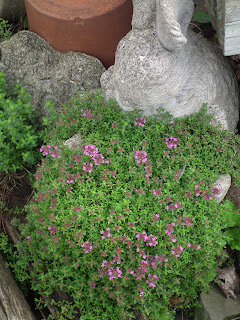Postcards From The Cave...
...Beams of wintery cold sunshine sneaked into my snowy cave of hibernation to disturb my naps. The roller coaster ride of temperatures was wreaking havoc on my body as Ohio experienced sub-zero torture one day and balmy 45 degree temperatures the next day. Enticed by the sunshine, I stirred from my winter lethargy to peek out to check the temperature of the day only to find a note from "The Groundhog" tacked to my door. "Don't bother getting up...no meld-down any time soon, love Phil."
As I sat drinking hot tea, trying to warm up enough to start my day, I began to have the first thoughts of little pots of herbs growing in my kitchen. The only good news about the severe cold this winter is that we shouldn't be plagued by bugs in this year's gardens. I was delighted to learn that the Herb of the Year is Artemisia. The fond memory of growing several varieties in stirred another interesting memory. During the local community fall festival, I had invited several Native American vendors to set up their tables on my property. My herb gardens were set up for self-guided tours during the festival. As some of the Native Americans walked through my gardens, they noticed my Artemisia plants. "You have sage in your gardens," they told me excitedly. I told them that the sage was on the other side of the gardens. They insisted that the Artemisia was the white sage that they used for smudging. I was impressed enough at learned something new about Artemisia that I cut some of the stalks to give to my vendors. (Artemisia tridentate: sagebrush, wormwood)
I have used Artemisia in many fun ways over the years. I like to create wreaths and swags mixing different varieties to give varying textures to my creations. The lacey textures and the gray-green color are perfect for decorating through the seasons. Of course I make sure I have enough dried Artemisia to create smudging sticks. Aside from any ceremonial reasons for smudging, using smudge sticks is a good way to cleanse the air in the house from any lingering germs during long winters of enclosure. Smudging has become part of my spring cleaning rituals. Artemisia can also be dried to use in making moth bags for drawers and closets. Artemisia is so lacey and has a beautiful gray color that makes for nice texture to add to winter potpourri blends, too.
Some of the Artemisia varieties can be used in culinary ways. Tarragon is used in cooking and in herbal vinegars. Artemisia absinthe is used to make the liqueur known as green absinthe.
Thinking about smudging, I realized that I was down to my last stick of Artemisia. I'll definitely have to get cracking on putting out new Artemisia plants as spring finally warms up Ohio. Not sure when that will happen, but there is the hope of warm days and warmer soil. Nothing like planning new garden ventures for clearing away winter cobwebs of the brain. I refuse to be daunted by The Groundhogs's curse!
As I sat drinking hot tea, trying to warm up enough to start my day, I began to have the first thoughts of little pots of herbs growing in my kitchen. The only good news about the severe cold this winter is that we shouldn't be plagued by bugs in this year's gardens. I was delighted to learn that the Herb of the Year is Artemisia. The fond memory of growing several varieties in stirred another interesting memory. During the local community fall festival, I had invited several Native American vendors to set up their tables on my property. My herb gardens were set up for self-guided tours during the festival. As some of the Native Americans walked through my gardens, they noticed my Artemisia plants. "You have sage in your gardens," they told me excitedly. I told them that the sage was on the other side of the gardens. They insisted that the Artemisia was the white sage that they used for smudging. I was impressed enough at learned something new about Artemisia that I cut some of the stalks to give to my vendors. (Artemisia tridentate: sagebrush, wormwood)
I have used Artemisia in many fun ways over the years. I like to create wreaths and swags mixing different varieties to give varying textures to my creations. The lacey textures and the gray-green color are perfect for decorating through the seasons. Of course I make sure I have enough dried Artemisia to create smudging sticks. Aside from any ceremonial reasons for smudging, using smudge sticks is a good way to cleanse the air in the house from any lingering germs during long winters of enclosure. Smudging has become part of my spring cleaning rituals. Artemisia can also be dried to use in making moth bags for drawers and closets. Artemisia is so lacey and has a beautiful gray color that makes for nice texture to add to winter potpourri blends, too.
Some of the Artemisia varieties can be used in culinary ways. Tarragon is used in cooking and in herbal vinegars. Artemisia absinthe is used to make the liqueur known as green absinthe.
Thinking about smudging, I realized that I was down to my last stick of Artemisia. I'll definitely have to get cracking on putting out new Artemisia plants as spring finally warms up Ohio. Not sure when that will happen, but there is the hope of warm days and warmer soil. Nothing like planning new garden ventures for clearing away winter cobwebs of the brain. I refuse to be daunted by The Groundhogs's curse!





Comments
Post a Comment